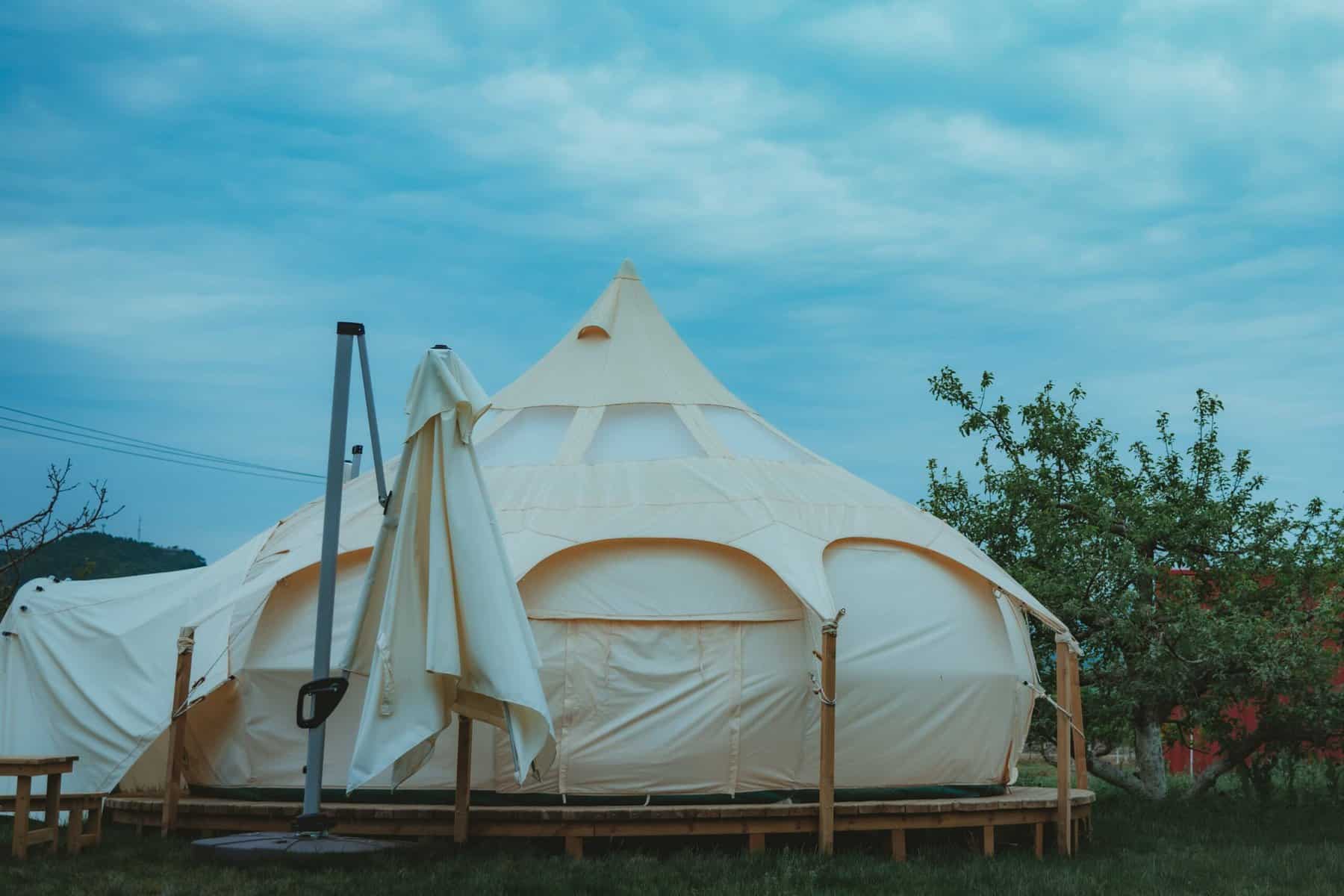Camping has long been a beloved pastime for nature enthusiasts and adventure seekers alike. However, traditional camping can also come with its fair share of challenges, from unpredictable weather conditions to the lack of basic amenities. Fortunately, a new form of camping has emerged in recent years that offers a more luxurious and comfortable experience: glamping.
Glamping, which stands for “glamorous camping,” combines the best of both worlds by allowing you to immerse yourself in the beauty of nature without sacrificing the comforts of modern life. From cosy yurts and luxurious tree houses to fully equipped RVs and upscale tents, there are a variety of glamping accommodations available to suit any preference and budget.
But what sets glamping apart from traditional camping? For starters, glamping provides a level of comfort and convenience that traditional camping simply can’t match. Glampers can enjoy plush bedding, private bathrooms, and even gourmet meals prepared by professional chefs, all while surrounded by stunning natural landscapes.
However, glamping is more than just a fancy camping trip. It offers a unique way to experience the great outdoors while also connecting with fellow travellers and creating lasting memories. Whether you’re seeking a romantic getaway with your significant other or a fun family adventure, glamping provides the perfect opportunity to unwind, unplug, and appreciate the beauty of nature.
So, if you’re looking for a new way to experience the great outdoors, why not give glamping a try? In this post, we’ll explore the differences between glamping and traditional camping, as well as who glamping is best suited for and how to make the most of your glamping experience.
What is Traditional Camping
Definition of Traditional Camping:
Traditional camping is the classic and conventional way of camping, which involves setting up a tent, cooking meals over a fire, and sleeping in sleeping bags. It is a way of experiencing nature in its rawest form, without the luxuries of modern living. Traditional camping is all about disconnecting from technology and immersing oneself in the great outdoors.
Basic Equipment and Supplies Needed for Traditional Camping:
The basic equipment and supplies needed for traditional camping are relatively simple. A sturdy tent, sleeping bags, and sleeping pads are essential for a comfortable night’s sleep. You’ll also need a camp stove or fire pit for cooking meals, as well as a cooler for storing food and drinks. A first-aid kit, insect repellent, and sunscreen are also important items to include in your camping gear.
Advantages and Disadvantages of Traditional Camping:
One of the main advantages of traditional camping is the opportunity to disconnect from technology and immerse oneself in nature. Traditional camping also tends to be more affordable than glamping, as there are no accommodation costs beyond the initial investment in camping gear. Additionally, traditional camping can be a great way to bond with friends and family and create lasting memories.
However, there are also some disadvantages to traditional camping. Sleeping on the ground can be uncomfortable, and cooking over an open fire can be time-consuming and challenging, especially for those with limited outdoor experience. Furthermore, traditional camping can be affected by unpredictable weather conditions, which can make the experience less enjoyable.
Overall, traditional camping can be a rewarding and memorable way to experience the great outdoors. By understanding the basics of equipment and supplies needed, as well as the advantages and disadvantages, you can make an informed decision about whether traditional camping is right for you.
Differences between Glamping and Traditional Camping:
Comfort Level and Amenities:
One of the biggest differences between glamping and traditional camping is the level of comfort and amenities offered. Glamping accommodations provide the luxury of a hotel room with the unique experience of camping. Traditional camping, on the other hand, requires you to bring your own tent and gear, and may not offer the same level of comfort or convenience.
Location and Surroundings:
Glamping accommodations are often located in picturesque settings, such as national parks, scenic lake shores, and mountain ranges. Traditional camping offers a similar experience, but may require more effort to find the perfect spot. Additionally, glamping accommodations may provide a more comfortable and intimate experience of the natural surroundings.
Cost and Accessibility:
Glamping can be more expensive than traditional camping, as it offers a higher level of luxury and convenience. However, there are often options available for every budget. Traditional camping is generally less expensive, but may require more planning and preparation. Additionally, some glamping accommodations may not be accessible to those with mobility or other physical limitations.
Social Aspects and Activities:
Glamping can offer a unique social experience, as it often provides opportunities for group activities and socialising with other guests. Traditional camping can also provide a social experience but may require more effort to connect with other campers. Additionally, glamping accommodations often provide a wider range of activities and amenities, such as hiking, fishing, kayaking, and spa treatments, while traditional camping may require more self-sufficiency and planning for activities.
In summary, while both glamping and traditional camping offer unique ways to experience the great outdoors, there are significant differences between the two. By understanding these differences, you can choose the option that best suits your needs and preferences.
Who is Glamping For?
Ideal Audience for Glamping:
The ideal audience for glamping is diverse but tends to be people who are looking for a unique and comfortable outdoor experience. Glamping can be particularly appealing to those who are not interested in traditional camping, but still want to enjoy the great outdoors. It may also appeal to those who want to combine luxury and adventure, such as couples seeking a romantic getaway or families looking for a fun and relaxing vacation.
Reasons Why People Choose Glamping over Traditional Camping:
There are several reasons why people choose glamping over traditional camping. For one, glamping accommodations offer a high level of comfort and convenience, often including amenities such as real beds, running water, and electricity. Glamping also provides a unique experience of the natural surroundings, allowing guests to enjoy the beauty of nature without sacrificing comfort. Additionally, glamping accommodations often offer a wider range of activities and experiences, such as spa treatments, gourmet meals, and guided tours.
Ways to Make Glamping More Appealing to a Wider Audience:
To make glamping more appealing to a wider audience, there are several strategies that can be employed. One approach is to expand the range of accommodations available, such as adding more affordable options or including accommodations designed specifically for families. Another approach is to offer more unique and personalised experiences, such as tailored tours or special events. Additionally, offering a wider range of activities and amenities, such as yoga classes, cooking workshops, or cultural experiences, can help make glamping more appealing to a wider audience.
In summary, the ideal audience for glamping is diverse, but tends to be people who want a unique and comfortable outdoor experience. There are several reasons why people choose glamping over traditional camping, including the high level of comfort and convenience offered by glamping accommodations. To make glamping more appealing to a wider audience, it may be useful to expand the range of accommodations available, offer more personalised experiences, and provide a wider range of activities and amenities.
Conclusion
In conclusion, we have explored the key differences between glamping and traditional camping, including the level of comfort and amenities offered, location and surroundings, cost and accessibility, and social aspects and activities. We also discussed the ideal audience for glamping, the reasons why people choose glamping over traditional camping, and ways to make glamping more appealing to a wider audience.
Understanding the difference between glamping and traditional camping can help you make an informed decision about which type of outdoor experience is right for you. Whether you are looking for a rustic adventure or a luxurious getaway, there is an option that can suit your needs and preferences.
In our opinion, both glamping and traditional camping have their unique benefits and drawbacks, and the best option depends on individual preferences and goals. That being said, we believe that glamping offers a particularly appealing way to enjoy the great outdoors, combining the beauty of nature with the comfort and convenience of modern amenities.
We encourage our readers to try glamping and share their own experiences with us. Whether you are a seasoned camper or new to outdoor adventures, glamping can be a fun and rewarding way to explore the natural world. So why not give it a try and see for yourself why glamping is becoming such a popular trend?



